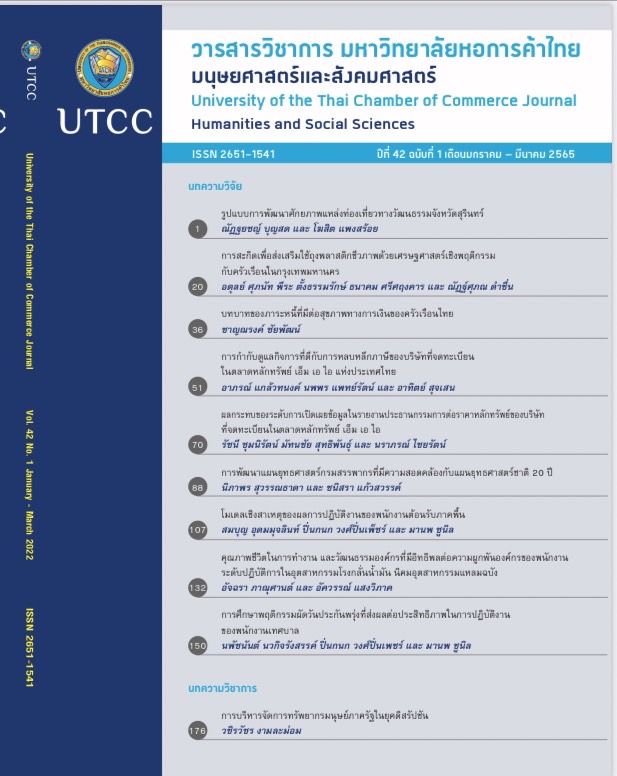โมเดลเชิงสาเหตุของผลการปฏิบัติงานของพนักงานต้อนรับภาคพื้น
Main Article Content
บทคัดย่อ
การศึกษาในครั้งนี้มีวัตถุประสงค์เพื่อตรวจสอบความเที่ยงตรงของโมเดลความสัมพันธ์เชิงสาเหตุของ
ผลการปฏิบัติงานพนักงานต้อนรับภาคพื้นกับข้อมูลเชิงประจักษ์ กลุ่มตัวอย่าง คือ พนักงานต้อนรับภาคพื้น จาก
4 ผู้ประกอบการในธุรกิจสายการบินที่ให้บริการด้านการให้บริการผู้โดยสารภาคพื้น จำนวน 653 คน เครื่องมือ
คือ แบบสอบถาม สำหรับเก็บรวบรวมข้อมูลของ 5 ตัวแปร ได้แก่ ความฉลาดทางวัฒนธรรม การปรุงแต่ง
อารมณ์ การรับรู้ความสามารถของตนเองในการปฏิบัติงาน ความเครียดในงาน และผลการปฏิบัติงาน โดยใช้
การวิเคราะห์โมเดลสมการโครงสร้าง ผลการศึกษา พบว่า โมเดลความสัมพันธ์เชิงสาเหตุของผลการปฏิบัติงาน
ของพนักงานต้อนรับภาคพื้นมีความสอดคล้องกลมกลืนกับข้อมูลเชิงประจักษ์ โดยพิจารณาจากค่าของตัวชี้วัด
ดังต่อไปนี้ ค่าไคสแควร์ (Chi-square) เท่ากับ 51.167 ค่าองศาอิสระ (Degree of Freedom) เท่ากับ 37
ค่าไคสแควร์สัมพันธ์ (Relative Chi-square) มีค่าเท่ากับ 1.382 ค่าความน่าจะเป็น (p-value) มีค่าเท่ากับ
0.061 ค่าดัชนีรากที่สองของค่าเฉลี่ยความคลาดเคลื่อนกำลังสองของการประมาณค่า (RMSEA) มีค่า
เท่ากับ 0.024 ค่าดัชนีวัดระดับความสอดคล้องเปรียบเทียบ (CFI) มีค่าเท่ากับ 0.998 ค่าดัชนีวัดความกลมกลืน
(RFI) มีค่าเท่ากับ 0.990 ค่าดัชนีความสอดคล้องของโมเดล (GFI) มีค่าเท่ากับ 0.987 ค่าดัชนี
ความสอดคล้องของโมเดลที่ปรับแก้แล้ว (AGFI) มีค่าเท่ากับ 0.973 และค่าเฉลี่ยกำลังสองของส่วนเหลือ
ในรูปคะแนนมาตรฐาน (SRMR) มีค่าเท่ากับ 0.021 ทั้งนี้ตัวแปร ความฉลาดทางวัฒนธรรม การปรุงแต่งอารมณ์
การรับรู้ความสามารถของตนเองในการปฏิบัติงาน และความเครียดในงาน สามารถร่วมกันอธิบายความแปรปรวน
ของผลการปฏิบัติงานได้ ร้อยละ 57.6 โดยความฉลาดทางวัฒนธรรมมีอิทธิพลทางตรงต่อผลการปฏิบัติงาน
มากที่สุด
Article Details

This work is licensed under a Creative Commons Attribution-NonCommercial-NoDerivatives 4.0 International License.
ลิขสิทธิ์ของบทความ
ผลงานที่ได้รับการตีพิมพ์ถือเป็นลิขสิทธิ์ของมหาวิทยาลัยหอการค้าไทย ห้ามมิให้นำเนื้อหา ทัศนะ หรือข้อคิดเห็นใด ๆ ของผลงานไปทำซ้ำ ดัดแปลง หรือเผยแพร่ ไม่ว่าทั้งหมดหรือบางส่วนโดยไม่ได้รับอนุญาตเป็นลายลักษณ์อักษรจากมหาวิทยาลัยหอการค้าไทยก่อน
References
เก้ากล้า เกิดทวี. (2561). เป้าหมายเชิงกลยุทธ์ การรับรู้ความสามารถตนเองและการรับรู้ต่อผลการปฏิบัติงานของพนักงาน กรณีศึกษาเปรียบเทียบคณะทันตแพทยศาสตร์และคณะสาธารณสุขศาสตร์ ในสังกัดมหาวิทยาลัยธรรมศาสตร์ (วิทยานิพนธ์ปริญญามหาบัณฑิต ไม่ได้ตีพิมพ์). มหาวิทยาลัยธรรมศาสตร์,กรุงเทพฯ.
ธานินทร์ ศิลป์จารุ. (2560). การวิจัยและวิเคราะห์ข้อมูลทางสถิติด้วย SPSS และ AMOS (พิมพ์ครั้งที่ 17).กรุงเทพฯ: บิสซิเนสอาร์แอนด์ดี.
ปิยะนุช สถาพงศ์ภักดี. (2564, มีนาคม). ธุรกิจบริการขนส่งทางอากาศ. วิจัยกรุงศรี. สืบค้นจาก https://www.krungsri.com/getmedia/c8ca3a9b-43ee-4d82-872d-712ba3ba57cf/IO_Air_Transport_
_TH_EX.pdf.aspx
พลเทพ พูนพล. (2558). อิทธิพลของความฉลาดทางวัฒนธรรมที่มีต่อการปรับตัวข้ามวัฒนธรรมและผลการปฏิบัติงานของพนักงานข้ามชาติในประเทศไทย. วิทยาการวิจัยและวิทยาการปัญญา, 12(2), 109-121.
พัชรินทร์ โกญจนาทแสนยากร. (2551). ปัจจัยที่ก่อให้เกิดความเครียดในงาน ความสามารถในการเผชิญและฟันฝ่าอุปสรรคและความเครียดทั่วไป ที่ส่งผลต่อผลการปฏิบัติงานของพนักงานรัฐวิสาหกิจ: กรณีศึกษาองค์การเภสัชกรรม (วิทยานิพนธ์ปริญญามหาบัณฑิต ไม่ได้ตีพิมพ์). มหาวิทยาลัยธรรมศาสตร์, กรุงเทพฯ.
พิมพ์ ศรีทองคำ. (2557). ความเครียดในการปฏิบัติงาน ภาวะผู้นำ ที่ส่งผลต่อประสิทธิภาพในการปฏิบัติงานของพนักงานปฏิบัติการในบริษัทเอกชนที่นำเข้าและจัดจำหน่ายสินค้าแฟชั่นแห่งหนึ่ง (วิทยานิพนธ์ปริญญามหาบัณฑิต ไม่ได้ตีพิมพ์). มหาวิทยาลัยกรุงเทพ, กรุงเทพฯ.
พูลพงศ์ สุขสว่าง. (2557). หลักการวิเคราะห์โมเดลสมการโครงสร้าง. วารสารมหาวิทยาลัยนราธิวาสราชนครินทร์,6(2), 136-145.
ภริดา ตันติเวชเรืองเดช. (2556). ความสัมพันธ์ระหว่างความฉลาดทางวัฒนธรรมกับผลการปฏิบัติงาน โดยมีการช็อกทางวัฒนธรรมเป็นตัวส่งผ่าน: กรณีศึกษาแรงงานพม่าในจังหวัดระยอง (วิทยานิพนธ์ปริญญามหาบัณฑิต ไม่ได้ตีพิมพ์). มหาวิทยาลัยเกษตรศาสตร์, กรุงเทพฯ.
ศศิวรรณ อินทรวงศ์. (2560). อิทธิพลระหว่างการรับรู้ความสามารถในตนเอง การรับรู้ลักษณะงานที่ตนปฏิบัติ และคุณภาพชีวิตที่ดีในการทำงานที่มีต่อผลการปฏิบัติงานของบุคลากรในสถาบันอุดมศึกษากลุ่มใหม่(วิทยานิพนธ์ปริญญามหาบัณฑิต ไม่ได้ตีพิมพ์). มหาวิทยาลัยเทคโนโลยีราชมงคลธัญบุรี, ปทุมธานี.
ศูนย์วิจัยกสิกรไทย. (2559). บทวิเคราะห์แนวโน้มธุรกิจ: การเติบโตของธุรกิจการบินในไทย...โอกาสบนความท้าทายในการเป็นศูนย์กลางทางการบินครบวงจรของภูมิภาคอาเซียน. สืบค้นเมื่อ 11 เมษายน 2562,จาก https://www.kasikornresearch.com/th/analysis/k-econ/business/Pages/35734.aspx
สำนักงานการบินพลเรือนแห่งประเทศไทย, ฝ่ายเทคโนโลยีสารสนเทศและการสื่อสาร, กองเศรษฐกิจ การบิน.(2561). รายงานภาพรวมสถิติการขนส่งทางอากาศ พ.ศ. 2561. สืบค้นเมื่อ 11 เมษายน 2562, จาก https://www.caat.or.th/wp-content/uploads/2019/02/Final_Summary-of-Thai-airtransport-2018.pdf
สุรชัย ทุหมัด, และวิโรจน์ เจษฎาลักษณ์. (2562). ความเครียดและผลกระทบต่อผลการปฏิบัติงานของพนักงานในหน่วยงาน ด้านศิลปวัฒนธรรมของมหาวิทยาลัยในกำกับของรัฐ. วารสารสถาบันวัฒนธรรมและศิลปะมหาวิทยาลัยศรีนครินทรวิโรฒ, 9(2), 151-165. สืบค้นจาก https://so02.tci-thaijo.org/index.php/jica/article/download/129944/97605/
อภิพงศ์ บุญเก่า. (2557). ปัจจัยที่มีความสัมพันธ์กับความเครียดในการทำงานของพนักงานต้อนรับบนเครื่องบิน(วิทยานิพนธ์ปริญญาดุษฎีบัณฑิต ไม่ได้ตีพิมพ์). มหาวิทยาลัยปทุมธานี, ปทุมธานี.
อานันท์ รุจิวรารัตน์. (2559). ความเครียดของพนักงานบริการส่วนหน้าเมื่อแสดงความรู้สึกขณะปฏิบัติงาน(วิทยานิพนธ์ปริญญามหาบัณฑิต ไม่ได้ติพิมพ์). มหาวิทยาลัยศิลปากร, กรุงเทพฯ.
Aamodt, M. G. (2004). Applied industrial/organizational psychology (4th ed.). Australia: Wadsworth/Thomson Learning.
Ang, S., Van Dyne, L., Koh, C., Ng, K., Templer, K., Tay, C., & Chandrasekar, N. (2007). Cultural intelligence: Its measurement and effects on cultural judgment and decision making,cultural adaptation and task performance. Management and Organization Review, 3(3),335-371. doi:10.1111/j.1740-8784.2007.00082.x.
Badura, A. (1977a). Self-efficacy: Toward a unifying theory of behavioral chain. Psychological Review, 84(2), 191-215.
Badura, A. (1977b). Social learning theory. Englewood Cliffs, NJ: Prentice-Hall.
Borman, W. C & Motowido, S. J. (1997). Task performance and contextual performance: The meaning for personnel selection research. Human Performance, 10(2), 99-109.
Chen, A., Lin, Y., & Sawangpattanakul, A. (2011). The relationship between cultural intelligence and performance with the mediating effect of culture shock: A case from Philippine laborers in Taiwan. International Journal of Intercultural Relations, 35(2), 246-258.
Cooper, C. L., & Marshall, J. (1976). Occupational sources of stress: A review of the literature relating to coronary heart disease and mental ill health. Journal of Occupational Psychology, 49(1), 11-28.
Cortina, J. M. (1993). What is coefficient alpha psychology? An examination of theory and Applications. Journal of Applied Psychology, 78(1), 98-104.
Earley, P. C., & Ang, S. (2003). Cultural intelligence: Individual interactions across cultures. Redwood City, CA: Stanford University Press.
Field, A. (2005). Discovering statistics using SPSS (2nd ed.). London: Sage.
Haddad, S. I., & Taleb, R. A. (2016). The impact of self-efficacy on performance (An empirical study on business faculty members in Jordanian Universities). Computers in Human Behavior,55, 877-887.
Hair, Jr., J, F., Black, W. C., Babin, B. J., & Anderson, R. E. (2010). Multivariate data analysis:A global perspective (7th ed.). Upper Saddle River, NJ: Person Education.
Hochschild, A. (1979). Emotional work, feeling rules and social structure. American Journey, 85(3),551-575.
Hochschild, A. (1983). The managed heart commercialization of human feeling. Oakland, CA:University of California Press.
International Air Transport Association. (2021a). Airport handling manual (41st ed.). Canada: Author.
International Air Transport Association. (2021b). Ground operations manual (10th ed.). Canada: Author.
Isik, M., & Hamurcu, A. (2017). The role of job stress at emotional labor’s effect on intention to leave: Evidence from call center employees. Business and Economic Horizons, 13(5),652-665.
Ivancevich, J. M., Konopaske, R., & Matteson, M. T. (2014). Organizational behavior & management(10th ed). New York, NY: McGraw-Hill.
Luszczynska, A., Scholz, U., & Schwarzer, R. (2005). The general self-efficacy scale: Multicultural validation studies. The Journal of Psychology, 139(5), 439-457.
Mohr, A. T., & Puck, J. F. (2007). Role conflict, general manager job satisfaction and stress and the performance of IJVs. European Management Journal, 25(1), 25-35.
Morris, J. A., & Feldman, D. C. (1996). The dimensions, antecedents, and consequences of emotional labor. The Academy of Management Review, 21(4), 986-1010.
Prahara, S. A., & Indriani, N. (2019). Employees: Occupational self-efficacy and work stress. Journal of Psychology and Instruction, 3(3), 91-96.
Robbins, S. P., & Judge, T. A. (2017). Organizational behavior (17th ed). Upper Saddle River, NJ: Person Education.
Schultz, D. P., & Schultz, S, E. (1998). Psychology and work today: An introduction industrial and organizational psychology (7th ed.). Englewood Cliffs, NJ: Prentice-Hall.
Schumacker, R. E., & Lomax, R. G. (2016). A beginner’s guide to structural equation modeling (4th ed). New York, NY: Taylor & Francis.
Sezgen, E., Mason, K. J., & Mayer, R. (2019). Voice of airline passenger: A text mining approach to understanding customer satisfaction. Journal of Air Transport Management, 77(),65-74. doi:10.1016/j.jairtraman.2019.04.001.
Shah, F. T., Syed, Z., Imam, A., & Raza, A. (2020). The impact of airline service quality on passengers’ behavioral intentions using passenger satisfaction as a mediator. Journal of Air Transport Management, 85, 101815. doi:10.1016/j.jairtraman.2020.101815.
Sricharoenpramong, S. (2017). Service quality improvement of ground staff at Don Mueang International Airport. Kasetsart Journal of Social Sciences, 39, 15-21. doi:10.1016/j.kjss.2017.12.001.
Thomas, D. C., & Inkson, K. (2004). Cultural intelligence: People skills for global business. San Francisco, CA: Berrett Koehler.
Van Dyne, L., Ang, S., Ng, K.Y., Rockstuhl, T., Tan, M. L., & Koh, C. (2012). Sub-dimensions of the four factor model of cultural intelligence: Expanding the conceptualization and measurement of cultural intelligence. Social and Personality Psychology Compass 6(4),295-313. doi:10.1111/j.1751-9004.2012.00429.x.
Yang, C-H., & Chang, H-L. (2012). Exploring the perceived competence of airport ground staff in dealing with unruly passenger behaviors. Tourism Management, 33(3), 611-621.doi:10.1016/j.tourman.2011.07.001.

